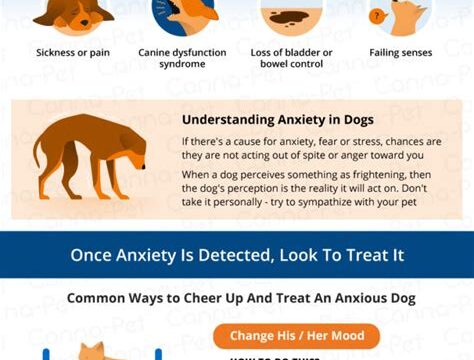Dogs are wonderful companions, but just like humans, they can experience fear and anxiety. As a dog owner, it’s important to understand the root causes of these emotions and how to help your furry friend manage them. In this blog post, we will explore a holistic approach to managing fear and anxiety in dogs. From identifying the signs of fear and anxiety to implementing positive reinforcement techniques, utilizing natural remedies and supplements, creating a safe and secure environment, developing a consistent daily routine, seeking professional help and guidance, and maintaining patience and persistence, we will cover a range of strategies to help your dog feel more calm and confident. Whether your dog experiences separation anxiety, noise phobias, or general fearfulness, this post will provide you with valuable insights and practical tips to support your beloved pet’s emotional well-being. Let’s dive into the world of managing fear and anxiety in dogs from a holistic perspective.
Understanding the root causes of fear and anxiety
Fear and anxiety are natural reactions for both humans and animals, including our beloved pets. It is important to understand the root causes of these emotions in order to better address and help our furry friends. One of the main reasons for fear and anxiety in dogs is a lack of socialization during their critical developmental period. This can lead to a fear of unfamiliar places, people, and other animals. Additionally, past traumatic experiences or abuse can also contribute to these feelings of fear and anxiety.
Another root cause of fear and anxiety in dogs is a lack of routine and predictability in their environment. Dogs thrive on consistency and when their daily routine is disrupted, it can lead to stress and anxiety. Loud noises, such as thunderstorms or fireworks, can also trigger fear and anxiety in dogs. Identifying these root causes is the first step in helping our canine companions overcome their fears and anxieties.
Understanding the root causes of fear and anxiety in dogs can also help us empathize with their experiences. By recognizing that these emotions are often a result of past experiences or a lack of socialization, we can approach our dogs with compassion and understanding. It is important to create a safe and secure environment for our furry friends while also implementing positive reinforcement techniques to help them overcome their fears and anxieties.
Addressing the root causes of fear and anxiety in dogs is crucial in helping them lead happy and healthy lives. By being mindful of their past experiences, providing a consistent routine, and creating a supportive environment, we can help our canine companions overcome their fears and anxieties and live life to the fullest.
Identifying signs of fear and anxiety in dogs
Dogs are known to be incredibly expressive animals, and it’s important for pet owners to be able to recognize the signs of fear and anxiety in their furry friends. One of the common signs of fear and anxiety in dogs is excessive barking or whining. This could indicate that the dog is feeling stressed or uncomfortable in a particular situation. Another sign to look out for is trembling or shaking, especially when there is no apparent cause for the behavior. This could be a sign of fear or anxiety in dogs.
It’s also important to pay attention to changes in body language, such as a tucked tail, pinned back ears, or a hunched posture. These are all signs that a dog may be feeling fearful or anxious. Additionally, excessive panting or drooling, yawning when not tired, and avoiding eye contact can all be indicators of stress and anxiety in dogs.
Another sign to watch for is destructive behavior, such as chewing on furniture or excessive digging. Dogs may engage in these behaviors as a way to cope with their feelings of fear or anxiety. Similarly, excessive grooming or licking can be a sign of stress or discomfort.
It’s important for pet owners to be attuned to their dog’s behavior and to seek professional guidance if they notice any of these signs of fear and anxiety. By recognizing these signs early on, pet owners can take steps to help their dogs feel more secure and comfortable in their environment.
Implementing positive reinforcement techniques
Positive reinforcement is a powerful tool for shaping the behavior of your dog. By using positive reinforcement techniques, you can effectively teach your dog desired behaviors and discourage unwanted ones. This method involves rewarding your dog for displaying the behavior you want to see, which increases the likelihood of them repeating that behavior in the future. For example, if you want to teach your dog to sit, you can use treats and praise as rewards when they sit on command.
Consistency is key when implementing positive reinforcement techniques. It’s important to reward your dog every time they display the desired behavior, especially in the initial stages of training. This helps your dog understand exactly what they’re being rewarded for and reinforces the behavior you want to see. Inconsistency can confuse your dog and make it harder for them to learn the desired behavior.
It’s also important to use the right rewards when implementing positive reinforcement techniques. While treats are a common choice, it’s important to find out what motivates your dog the most. Some dogs may be more motivated by toys, playtime, or even verbal praise. By understanding what your dog finds most rewarding, you can tailor your reinforcement techniques to suit their individual preferences.
Lastly, it’s crucial to be patient when using positive reinforcement techniques. Behavioral changes take time, and it’s important to set realistic expectations. Dogs learn at their own pace, and it’s important to remain consistent and persistent in your training efforts. By staying patient and persistent, you can effectively implement positive reinforcement techniques and see long-lasting results in your dog’s behavior.
Utilizing natural remedies and supplements
Many pet owners are turning to natural remedies and supplements to help with their dog’s anxiety and fear. These natural remedies can include herbs such as chamomile, valerian root, and passionflower, as well as supplements like CBD oil and melatonin. These options provide an alternative to traditional medication and can often be effective in promoting a sense of calm in anxious dogs.
When considering utilizing natural remedies and supplements, it is important to consult with a veterinarian to ensure the safety and appropriateness of the chosen products for your dog. Not all natural remedies and supplements are suitable for every dog, and dosages can vary greatly. A professional can provide guidance on the best options for your pet’s specific needs.
In addition to natural remedies, it is also crucial to address underlying factors contributing to your dog’s anxiety and fear. These factors can include environment, past experiences, genetics, and overall health. By addressing these root causes, you can better understand how to effectively utilize natural remedies and supplements in your dog’s treatment plan.
Overall, natural remedies and supplements can be an excellent addition to a comprehensive approach to managing your dog’s anxiety and fear. When used in conjunction with positive reinforcement techniques, a secure environment, and consistency, these remedies can contribute to a happier and healthier life for your beloved pet.
Creating a safe and secure environment
Creating a safe and secure environment for your furry friend is essential for their overall well-being and happiness. Whether you have a new puppy, an adult dog, or a rescue, it’s important to ensure that they feel safe and comfortable in their surroundings.
One way to create a safe environment is to puppy-proof your home. This means removing any potentially harmful objects or substances that your dog could come into contact with. This includes household cleaners, electrical cords, and small objects that could be choking hazards.
Another important aspect of a secure environment is providing a designated space for your dog to retreat to when they need some alone time. This could be a cozy bed in a quiet corner of the house or a crate that they can retreat to when they feel overwhelmed.
Additionally, ensuring that your dog gets regular exercise and mental stimulation can greatly contribute to their sense of safety and security. A tired dog is a happy dog, and regular physical and mental stimulation can help reduce anxiety and stress.
Developing a consistent daily routine
Developing a consistent daily routine for your dog is essential for their overall well-being. Dogs thrive on predictability and structure, and a consistent daily routine provides them with a sense of security and stability. This routine should include regular feeding times, walks, playtime, training sessions, and rest periods. By establishing a consistent daily routine, you can help your dog feel more secure and less anxious.
When developing a consistent daily routine, it’s important to consider your dog’s individual needs and preferences. Some dogs may prefer an early morning walk followed by breakfast, while others may be more active in the evening. Take into account your dog’s energy levels, age, and breed when planning their daily routine. By tailoring the routine to suit your dog’s specific needs, you can ensure that they are happy and content.
Consistency is key when it comes to developing a consistent daily routine for your dog. Try to stick to the same schedule each day, as this will help your dog feel more secure and less anxious. Dogs thrive on routine and predictability, and by maintaining a consistent daily routine, you can help reduce their stress and anxiety levels.
In addition to providing stability and structure, a consistent daily routine can also help with training and behavior modification. Dogs are creatures of habit, and by implementing a consistent daily routine, you can reinforce positive behaviors and discourage undesirable ones. By setting aside time each day for training, exercise, and play, you can help your dog develop good habits and reduce stress and anxiety.
Seeking professional help and guidance
When it comes to addressing fear and anxiety in dogs, there are times when seeking professional help and guidance is necessary. Professional help can come in the form of a certified dog trainer, animal behaviorist, or veterinarian with experience in behavior modification. These experts have the knowledge and experience to assess your dog’s specific issues and provide guidance on how to address them.
One of the benefits of seeking professional help is the personalized approach they can offer. Each dog is unique, and what works for one may not work for another. A professional can tailor a behavior modification plan to address your dog’s specific fears and anxieties, taking into account their breed, personality, and past experiences.
Another advantage of seeking professional help is access to resources and tools that may not be readily available to the average dog owner. This can include specialized training equipment, medications, or access to a network of other professionals for collaboration and support.
Seeking professional guidance also provides peace of mind for owners, knowing that they are taking the right steps to help their dog. With their expertise, professionals can help owners navigate through the process of behavior modification, offering support and reassurance along the way.
Maintaining patience and persistence in the process
When it comes to helping dogs overcome fear and anxiety, it’s important to emphasize the importance of patience and persistence in the process. Dogs, especially those with deeply ingrained fears, may take a considerable amount of time to show progress. It’s crucial for dog owners to remain patient and consistently offer support as their furry friends work through their issues.
Some dogs may show immediate improvement with training and behavior modification, while others may require weeks or even months of consistent work to see positive results. It’s essential to understand that each dog is unique and will require a different approach to overcoming their fears and anxieties.
Additionally, maintaining patience and persistence also involves celebrating small victories along the way. Whether it’s a shy dog approaching a new person or a fearful dog showing signs of relaxation in a previously stressful situation, acknowledging these milestones can help keep both the dog and the owner motivated to continue working towards progress.
Overall, maintaining patience and persistence in the process of helping dogs overcome fear and anxiety is crucial for long-term success. By understanding that it’s a journey that requires consistent effort and unwavering support, dog owners can make a significant difference in their pet’s well-being.





